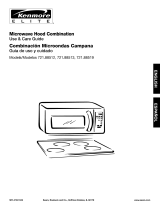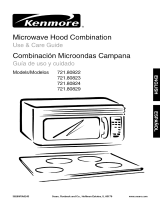
FOOD CHARACTERISTICS & MICROWAVE COOKING
Keeping an eye on things
The recipes in this book have been formulated
with great care, but your success in preparing
them depends on how much attention you pay to
the food as it cooks. Always watch your food
while it cooks. Your microwave oven is equipped
with a light that turns on automatically when the
oven is in operation so that you can see inside
and check the progress of your food. Directions
given in recipes to elevate, stir, and the like
should be thought of as the minimum steps
recommended. If the food seems to be cooking
unevenly, simply make the necessary
adjustments you think appropriate to correct the
problem.
Factors affecting microwave cooking times
Many factors affect cooking times. The
temperature of ingredients used in a recipe
makes a big difference in cooking times. For
example, a cake made with ice-cold butter, milk,
and eggs will take considerably longer to bake
than one made with ingredients that are at room
temperature. All of the recipes in this book give a
range of cooking times. In general, you will find
that the food remains under-cooked at the lower
end of the time range, and you may sometimes
want to cook your food beyond the maximum time
given, according to personal preference. The
governing philosophy of this book is that it is best
for a recipe to be conservative in giving cooking
times. While overcooked food is ruined for good.
Some of the recipes, particularly those for bread,
cake, and custards, recommend that food be
removed from the oven when they are slightly
undercooked. This is not a mistake. When
allowed to stand, usually covered, these foods
will continue to cook outside of the oven as the
heat trapped within the outer portions of the food
gradually travels inward. If the food is left in the
oven until it is cooked all the way through, the
outer portions will become overcooked or even
burnt. You will become increasingly skilful in
estimating both cooking and standing times for
various foods.
Density of food
Light, porous food such as cakes and bread cook
more quickly than heavy, dense foods such as
roasts and casseroles. You must take care when
microwaving porous food that the outer edges do
not become dry and brittle.
Height of food
The upper portion of tall food, particularly roasts,
will cook more quickly than the lower portion.
Therefore, it is wise to turn tall food during
cooking, sometimes several times.
Moisture content of food
Since the heat generated from microwaves tends
to evaporate moisture, relatively dry food such as
roasts and some vegetables should either be
sprinkled with water prior to cooking or covered to
retain moisture.
Bone and fat content of food
Bones conduct heat and fat cooks more quickly
than meat. Care must be taken when cooking
bony or fatty cuts of meat that they do not cook
unevenly and do not become overcooked.
Quantity of food
The number of microwaves in your oven remains
constant regardless of how much food is being
cooked. Therefore, the more food you place in
the oven, the longer the cooking time. Remember
to decrease cooking times by at least one third
when halving a recipe.
Shape of food
Microwaves penetrate only about 2.5 cm into
food, the interior portion of thick foods are cooked
as the heat generated on the outside travels
inward. Only the outer edge of food is cooked by
microwave energy; the rest is cooked by
conduction. The worst possible shape for a food
that is to be microwaved is a thick square. The
corners will burn long before the centre is even
warm . Round thin foods and ring shaped foods
cook successfully in the microwave.
Covering
A cover traps heat and steam which causes food
to cook more quickly. Use a lid or microwave
cling film with a corner folded back to prevent
splitting.
Browning
Meats and poultry that are cooked fifteen minutes
or longer will brown lightly in their own fat. Food
that is cooked for a shorter period of time may be
brushed with a browning sauce such as
Worcestershire sauce, soy sauce or barbecue
sauce to achieve an appetizing colour. Since
relatively small amounts of browning sauce is
added to food, the original flavour of the recipe is
not altered.
Covering with greaseproof paper
Greaseproofing effectively prevents spattering
and helps food retain some heat. But because it
makes a looser cover than a lid or clingfilm, it
allows the food to dry out slightly.
Arranging and spacing
Individual foods such as baked potatoes, small
cakes and hors d’oeuvres will heat more evenly if
placed in the oven an equal distance apart,
preferably in a circular pattern. Never stack foods
on top of one another.
18





















